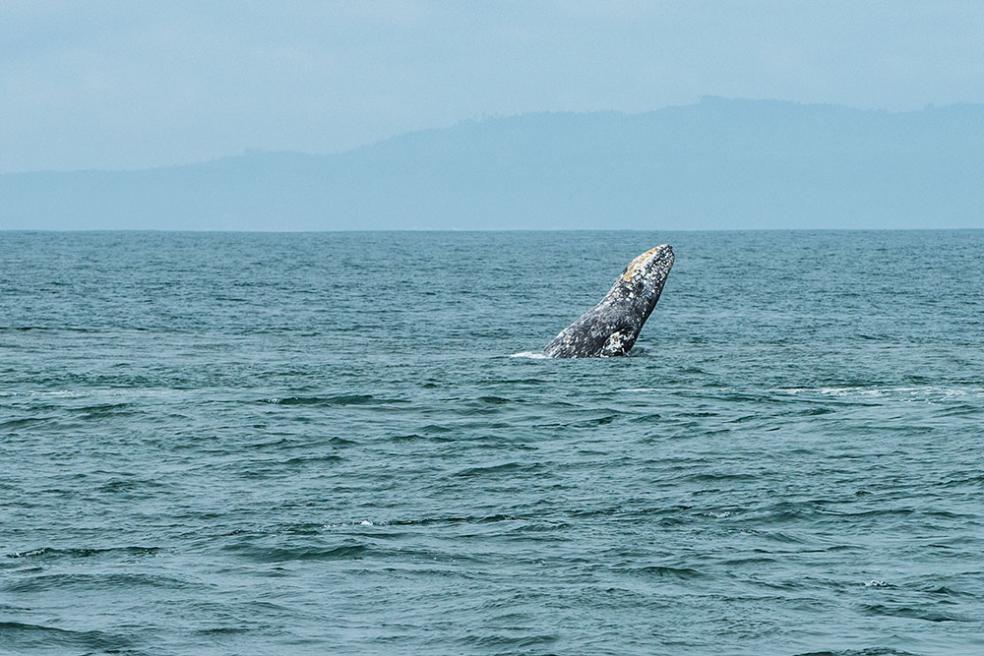
Some of the subgroup of 230 whales, known as the Pacific Coast Feeding Group (PCFG), can be seen in the waters off of Humboldt and Del Norte counties from June to November each year. The group makes up less than 1% of the population. While they have been observed here since the 1980s, researchers are still learning more about why exactly they spend their summers here instead of in their traditional feeding grounds in the Arctic.
The quantity and diversity of food found along the stretch of coastline could be supporting the group that stays here. Previous studies from Cal Poly Humboldt’s Biological Sciences Professor Dawn Goley and the University’s Marine Mammal Education and Research Program (MMERP) have found that certain gray whale prey, including the cumacean, Diastylopsis dawsoni (a species of shrimp), is found in Northern California waters. But the shrimp do not appear in the same diversity or quantity elsewhere in the PCFG’s range.
Norman, who has studied the whale’s foraging habits for more than two years, believes that their shortened migration is due to a tradeoff between the time and energy spent traveling and foraging in the Arctic and the food available in the north Pacific.
“Foraging plays an important role in all aspects of a gray whale's life, including their survival, growth, and reproductive success,” she says. “By monitoring the whale population and simultaneously tracking the changes in their food, we can understand each individual’s year-to-year success and the overall population's success across time and space.”
Norman knew from a young age that she wanted to work with animals. She began studying gray whales as an undergraduate at Oregon State University before beginning her graduate work at Cal Poly Humboldt in 2021.
As part of her research, she observes the whales by land and sea, collecting prey and identifying the pod’s individuals—some of which have been documented here for more than 20 years. She conducts boat surveys on a small Cal Poly Humboldt research vessel, and weekly land-based surveys from Trinidad to Point Saint George, California. During these surveys, she observes the abundance of gray whales, gathers behavioral data, and more. She also collects samples of the whale’s prey, some of which are collected in the presence of feeding whales.
Those samples are brought back to the Telonicher Marine Lab where they are analyzed with help from Biological Sciences Professor Paul Bourdeau and undergraduate interns. Norman then compares the quality and quantity to other prey items in Oregon, Washington, and the Arctic to better understand the whales’ motivations for spending time here.
Now with two years of data Norman can evaluate prey diversity changes over time across foraging areas in Northern California and determine if that corresponds to whale presence.
Her research is supported by grants from the Sequoia Park Zoo, CSU Council on Ocean Affairs, the National Oceanic and Atmospheric Administration (NOAA), the National Marine Mammal Laboratory (NMML), Humboldt Marine and Coastal Science Institute, and more.
"Gray whales, in particular the PCFG, are a very special species to study in Northern California as we can observe them close to shore along some of the most scenic locations on the West Coast,” Norman says. “I have been very fortunate that gray whale research at Cal Poly Humboldt has been established for many years by the MMERP and has been an ongoing collaborative effort across the University."
Norman hopes her work inspires other students to get involved in research and science, and promotes future conservation of the species.
“I hope that this renewed effort to understand gray whale foraging habits has an impact on our connections to these individuals and the protections we give them,” she says. “A lot of changes will be happening to our nearshore habitats where these whales migrate and forage, and I hope their presence is considered in the future of natural resource management, fisheries, and overall usage of the North Coast.”
All work was done under NOAA/NMF permit #22306